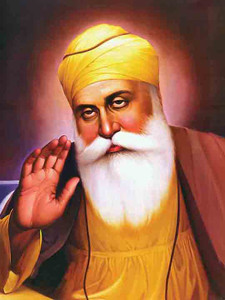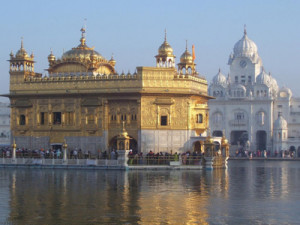Paul Derengowski, ThM
Introduction
 Of all the religious movements in India, Sikhism could be considered the “new kid on the block,” having begun in the fifteenth century A.D. through the excitement and devotion of young man by the name of Nanak. He, though, merely capitalized on a growing unrest in the Hindu culture in which he lived. Prior to his formation of what would later become the Sikh movement, he was preceded by a Muslim poet by the name of Kabir, who hated both the Hindu idols, as well as the religious ritualism that went with them. Nanak, being the strict monotheist, followed in the footsteps of Kabir and took what he considered the best of both Muslim and Hindu thought and melded them into his own distinct religion of Sikhism (“disciples”).
Of all the religious movements in India, Sikhism could be considered the “new kid on the block,” having begun in the fifteenth century A.D. through the excitement and devotion of young man by the name of Nanak. He, though, merely capitalized on a growing unrest in the Hindu culture in which he lived. Prior to his formation of what would later become the Sikh movement, he was preceded by a Muslim poet by the name of Kabir, who hated both the Hindu idols, as well as the religious ritualism that went with them. Nanak, being the strict monotheist, followed in the footsteps of Kabir and took what he considered the best of both Muslim and Hindu thought and melded them into his own distinct religion of Sikhism (“disciples”).
The road for Nanak was not a smooth one. Early on in his life he was not noted for his work ethic. In fact, his own father seemed to be quite distraught over his apparent laziness. Nanak enjoyed poetry and mystical contemplation, which did not set well with his father. In an effort to hopefully change young Nanak’s attitude, his father, along with a suggestion of his brother-in-law, sent him to work for the government in Sultanpur.((David S. Noss, A History of the World’s Religions, 12th ed. (Upper Saddle River: Pearson, 2008), 242.)) All went well, but it did not change young Nanak’s outlook. He married at the age of 12 and eventually fathered two children. One day after taking a bath Nanak would have a mystical experience in a forest where allegedly the God of the Universe, “True Name,” appeared to him in a vision. Thereafter, Nanak would go ahead and start his own religious movement along with the help of Muslim friend by the name of Mardana, who would be his music minister. That movement would evolve into today’s contemporary Sikh religion.
Nanak’s obedience involved not only the development of a distinct wardrobe, which combined facets of both Hinduism and Islam, but a distinct hierarchy of gurus that would eventually culminate in the worship of a book, the Adi Granth. Nanak, therefore, set forth with his minstrel, Mardana, to preach his newfound message. It would take some time before many would accept it. Shortly before Nanak celebrated his forty years of wandering and preaching his cohort, Mardana, dies. It would not be long until Nanak succumbed to the same. Yet, even in death legend has it that Nanak was still seen as a reconciler of both the Hindus and Muslims. Macauliffe recounts the events leading up to his death and the respect that Nanak had garnered from both Hindu and Muslim factions.
hierarchy of gurus that would eventually culminate in the worship of a book, the Adi Granth. Nanak, therefore, set forth with his minstrel, Mardana, to preach his newfound message. It would take some time before many would accept it. Shortly before Nanak celebrated his forty years of wandering and preaching his cohort, Mardana, dies. It would not be long until Nanak succumbed to the same. Yet, even in death legend has it that Nanak was still seen as a reconciler of both the Hindus and Muslims. Macauliffe recounts the events leading up to his death and the respect that Nanak had garnered from both Hindu and Muslim factions.
The Musalmans who had received God’s name from the Guru, said they would bury him after his death. His Hindu followers on the contrary said they would cremate him. When the Guru was invited to decide the discussion he said, ‘Let the Hindus place flowers on my right, and the Musalmans on my left. They whose flowers are found fresh in the morning, may have the disposal of my body.’
After a time of singing and revelry, Nanak passes, and a sheet is drawn over his body and face. Macauliffe continues,
When the sheet was removed next morning, there was nothing found beneath it. The flowers on both sides were in bloom. The Hindus and the Musalmans removed their respective flowers. All the Sikhs reverently saluted the spot on which the Guru had lain. He breathed his last on the tenth day of the light half of the month of Assu, Sambat 1595 (A.D. 1538) at Kartarpur in the Panjab.((Max Arthur Macauliffe, The Sikh Religion, 6 vols. (Amritsar: Satvic, reprint 2009), 1:190-91.))
Sikh Development
 When Nanak began Sikhism it was merely a movement and not a religion. It would not be until a character by the name of Guru Arjan (1563-1606) would officially give Sikhism its religious status. When he did so he had the Sikhs build what is known as the Golden Temple at Amritsar in the Punjab region of northern India. To help preserve Sikh teaching he also created the Sikh holy book known as the Adi Granth or the Guru Granth Sahib (“original collection”), which not only became the last Guru among the Sikhs, but it is now treated as if it is a human being as well. Interestingly enough, the Adi Granth not only preserves Sikh teaching, but others as well, since in the words of Indian philosopher Sarvepalli Radhakrishnan, “This is in consistency with the tradition of India which respects all religions and believes in the freedom of the human spirit. Indian spiritual tradition is not content with mere toleration. There can be no goodwill or fellowship when we only tolerate each other.”((The Sacred Writings of the Sikhs, trans. by Trilochan Singh, Jodh Singh, Kapur Singh, Bawa Harkisehn Singh, and Kushwant Singh (New York: UNESCO, 2007), 18.))
When Nanak began Sikhism it was merely a movement and not a religion. It would not be until a character by the name of Guru Arjan (1563-1606) would officially give Sikhism its religious status. When he did so he had the Sikhs build what is known as the Golden Temple at Amritsar in the Punjab region of northern India. To help preserve Sikh teaching he also created the Sikh holy book known as the Adi Granth or the Guru Granth Sahib (“original collection”), which not only became the last Guru among the Sikhs, but it is now treated as if it is a human being as well. Interestingly enough, the Adi Granth not only preserves Sikh teaching, but others as well, since in the words of Indian philosopher Sarvepalli Radhakrishnan, “This is in consistency with the tradition of India which respects all religions and believes in the freedom of the human spirit. Indian spiritual tradition is not content with mere toleration. There can be no goodwill or fellowship when we only tolerate each other.”((The Sacred Writings of the Sikhs, trans. by Trilochan Singh, Jodh Singh, Kapur Singh, Bawa Harkisehn Singh, and Kushwant Singh (New York: UNESCO, 2007), 18.))
According to Molloy, “At the Golden Temple in Amritsar, it [the Adi Granth] is brought out in the early morning by a gloved attendant, set on a cushion under a canopy, read from aloud by professional readers, fanned throughout the day, and then ‘put to bed’ at night.”((Michael Molloy, Experiencing the World’s Religions (New York: McGraw Hill, 2008), 208. Bowker claims that the Adi Granth is arisen at “five o’clock every morning.” John Bowker, World Religions: The Great Faiths Explored & Explained (New York: DK Publishing, 2006), 93.))
cushion under a canopy, read from aloud by professional readers, fanned throughout the day, and then ‘put to bed’ at night.”((Michael Molloy, Experiencing the World’s Religions (New York: McGraw Hill, 2008), 208. Bowker claims that the Adi Granth is arisen at “five o’clock every morning.” John Bowker, World Religions: The Great Faiths Explored & Explained (New York: DK Publishing, 2006), 93.))
Finally, Guru Arjan refused to subjugate himself and the Sikhs to Muslim rule, which eventuated in his martyrdom, but also gave impetus to succeeding gurus (Guru Har Govind and Guru Gobind Rai) to develop the military means by incorporating the disenfranchised—the “untouchables”—to a formidable army called the Khalsa. Khalsa literally means “pure” and is derived from Arabic, and is applicable to those who have accepted the Sikh baptism of the sword.((Macauliffe, The Sikh Religion, 5:95, n. 1.)) The Khalsa members were expected to not only live according to a certain code of conduct, but became the defense mechanism, early on, against attack my Muslim terrorist of the day. “They were ever to help the poor and protect those who sought their protection. They must not look with lust on another’s wife or commit fornication, but adhere to their wedded spouses. They were to consider their previous castes erased, and deem themselves all brothers of one family.”((Ibid, 5:95.))
The “Five K’s” of the Sikh Khalsa
 Kesh: uncut hair and beard, which symbolized the lion and its power; the hair on the man’s head is usually worn in a topknot and covered with a turban or cloth, which is considered sacred.
Kesh: uncut hair and beard, which symbolized the lion and its power; the hair on the man’s head is usually worn in a topknot and covered with a turban or cloth, which is considered sacred.- Khanga: the hair comb which is used to hold long hair in place.
- Kach: special undergarments which symbolize alertness and readiness to fight.
- Kirpan: the small dagger or sword which is used only for defensive purposes.
- Kara: a bracelet of steel which is worn to symbolize strength.
Sikh Holy Books
- Adi Granth (“original collection”): compiled by Guru Arjan (1563-1606)
- Guru Granth Sahib: compiled by the tenth Gura Gobind Singh (1666-1708)
Distinct Beliefs & Practices
- True God has two natures: material & spiritual. He has existed before time began.
- Humans are inherently good, as well as inherently equal.
- Sin essentially consists of worldly attachment, pride, anger, lust, and greed.
- Salvation consists of breaking the cycle of death and rebirth (reincarnation), especially through good works. One deserves God’s grace because one has earned it.
- The true afterlife consists of being absorbed into True God, since in Sikhism there is no officially accepted view of heaven or hell. Death is not to be mourned.
- There is no caste system, since all have been created equally; women are to be accepted alongside men.
- Conversion in Sikhism is through attraction, not active evangelism. “To become a Sikh one must declare one’s total faith in the Guru’s word, surrender to the Lord’s divine will and accept the baptism of the sword administered by five baptised [sic] Sikhs in the presence of Guru Granth Sahib.”((Gurbachan Singh Sidhu, An Introduction to Sikhism (Roseville, CA: Khalsa Tricentennial Foundation of North America, 2003), 36.)) Afterward, one must adhere to the “Five K’s.”
- The Khalsa ceremony is where initiates drink sugar water (Amrit or “nectar”) stirred with a dagger to become Sikhs. All males receive the surname of Singh; females Kaur.
Sikh Worship
- Is done in a temple called a Gurdwaras. “There are no professional priests in Sikhism nor any vows of celibacy for any person acting as such. Sikhism is essentially egalitarian…Women can also conduct services and act as Granthis (Readers of the Holy Granth).((Ibid. 38-39.))
- Most services are held on Sundays, although Sikhs are encouraged to repeat hymns and prayers regularly as time and occasion warrant.
- Worship includes singing, meditation, and reading from the Granth Sahib.
- The most important Sikh temple is found in Amritsar, Punjab, India. The Gurdwara, otherwise, is considered a sacred place where Sikhs gather to honor and worship True Name under the guidance of the Granth Sahib.
Succession of Sikh Gurus
- Guru Nanak, 1469-1539
- Guru Angad, 1504-1552
- Guru Amar Dās, 1479-1574
- Guru Ram Dās, 1534-1581
- Guru Arjan, 1563-1606
- Guru Har Govind, 1595-1644
- Guru Har Rai, 1630-1661
- Guru Harkishan, 1656-1664
- Guru Tegh Bahadur, 1621-1675
- Guru Gobind Singh, 1666-1708
- Guru Granth Sahib
Evaluation
Sikhism is a syncretistic religion, combining elements of both Hinduism and Islam at the outset, and then incorporating various other elements from other religious ideologies as the religion or the Guru at the moment sees fit. Most of those adhering to Sikhism do not see a problem with such an eclectic approach to religion, probably because none of them have a firm understanding that truth cannot be promoted when two ideas contradict. For instance, in Hinduism there are an almost infinite number of deities which allegedly exist, while in Islam there is only one. Nanak determined that there was only one deity, yet the Sikhs do not have a problem with embracing other equally problematic ideas which Hindus adhere, such as reincarnation, which is a totally irrational concept. The same applies to the acceptance of the Muslim practice of eating meat, which totally contradicts what the Hindus believe. And those are only two examples which exist between Islam and Hinduism; when one get into other doctrines stemming from other religions, then Sikhism, while attractive on the surface, is fraught with the contradictions and inequities which follow all syncretistic or relativistic religions and ideologies.
Therefore, although Sikhs are generally hospitable people and are willing to accept just about anyone or protect those who ask for their help, the religion that they propagate clearly does not represent the “True Name” of God, given that the relativism which undergirds their worldview also undermines everything that is true. One cannot in one breath claim that something is true, while in the next breath embrace that which is its antithesis, or false, and then assume to be able to rationally walk through life. Truth is absolute and cannot entertain a series of syncretistic ideas which contradict it, and yet remain true. Yet, within Sikhism that is exactly what we see. It is a religion comprised of a series of conflicted ideas about God and reality that cannot stand the most basic test for truth, and that is contradiction. Since Sikhism cannot live up to what is absolutely “True,” then for those seeking the truth within its system do so in futility. The absolute truth can only be found in the person of Jesus Christ. Therefore, one would only be doing oneself a favor by exploring just why Jesus is “the way, the truth, and the life,” rather than wasting one’s time, resources, and life looking elsewhere.

So reincarnation is irrational but belief in Heaven and Hell is quite rational eh my friend. And I believe virgin birth is also quite rational. But a man supposedly saving everybody by dying on a cross is quite rational. I bet you also believe that earth is 5000 years old and it is actually the sun revolving around the earth. Yup rational beliefs my friend. So how is your pet unicorn eh my Christian friend. The Turks said the right thing arguing with a Christian is insulting your intelligence.
Yes, heaven and hell are rational and reincarnation is not.
Yes, the virgin birth is rational.
Yes, Jesus’ crucifixion to redeem mankind is rational.
No, you just lost your bet.
Yes, the first three are rational, but the last one is a projection on your part that you managed to lose your bet.
I don’t have any pet unicorns.
Since you have not presented an argument, and you certainly have not engaged in any argument presented on this site, then deferring to the nebulous Turk would be irrational. So, just who is trying to insult whose intelligence?
There is much wrong with your assumptions, but for starters, if you believe in reincarnation, well that’s supposed to work via karma. That means even a baby is raped and killed, they deserved it, because of sins in a past life. That sit well with you? If you believe in the God of the Bible, however, he is the epitome of good. Evil is simply the absence of that which is good, just as darkness is simply the absence of light. If God is good, then he is also Just, and if he is Just, then sin requires punishment. So in that scenario I gave, evil exists where God is rejected, and God allows us to reject him because, being good, he gave us free will. Therefor, a place of eternal separation from God existing is logical, for those who have rejected him – he is simply giving people like you what they want, an absence of God. Unfortunately for you, an absence of God is also an absence of all things that God is, such as goodness, love, joy, peace, etc. All you are left with is the absence of those, or the antithesis of those. In the scenario I have, the child rapist & killer obviously rejects God and his authority, and would therefor end up in such a place. Sounds much more rational to me than letting him be reincarnated!
Liz,
There is no such thing as “free will.” That is a pagan idea derived of Epicurus, millennia ago that many, Christians and otherwise, have imported into their worldviews. May I suggest that you read my article, “Epicurus” Atominic, Free-will, Hedonist,” for further clarity on the subject.